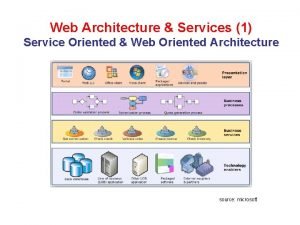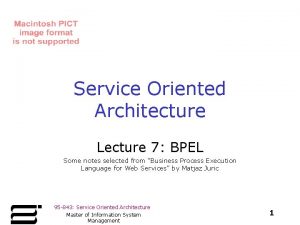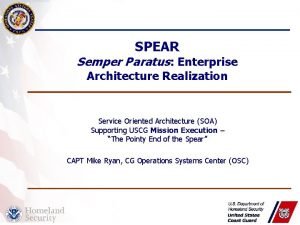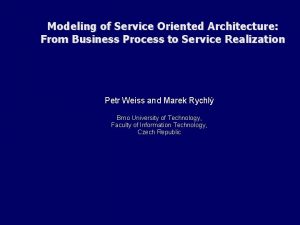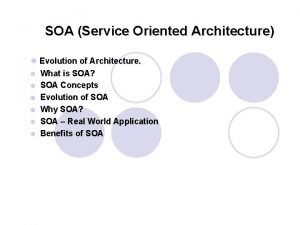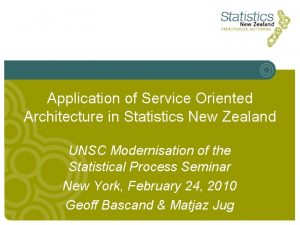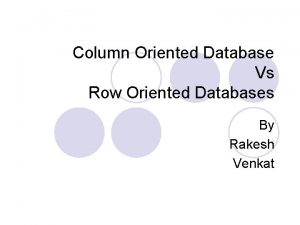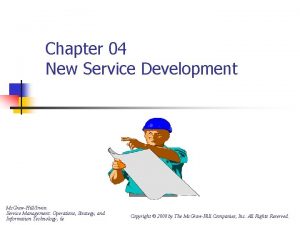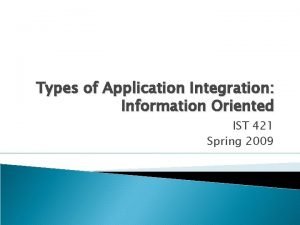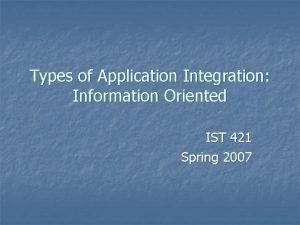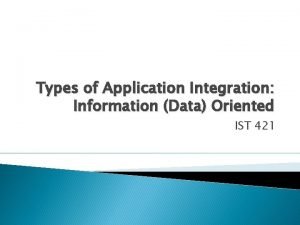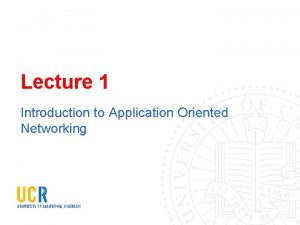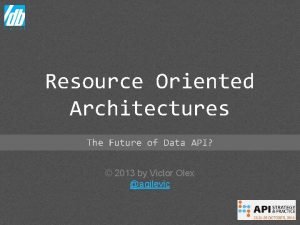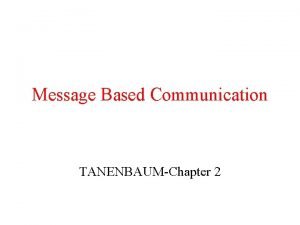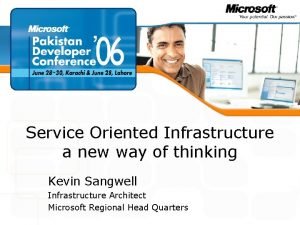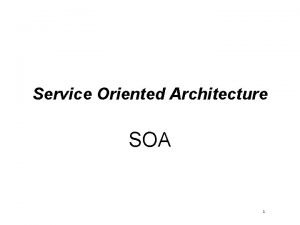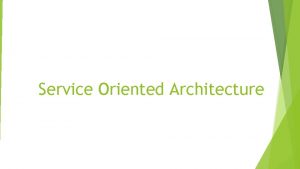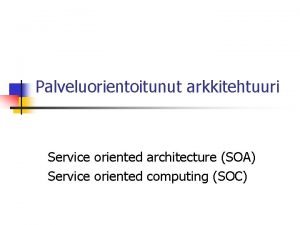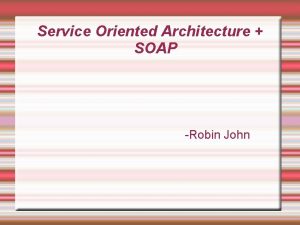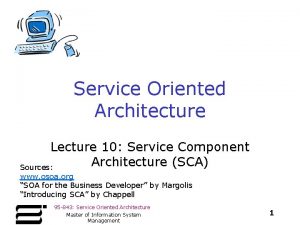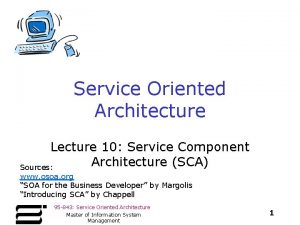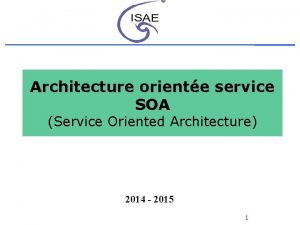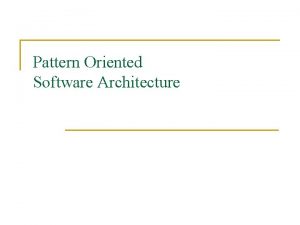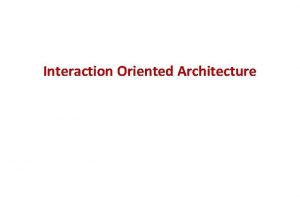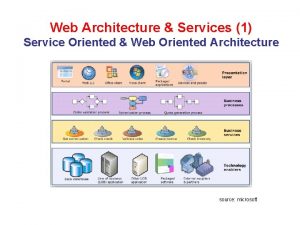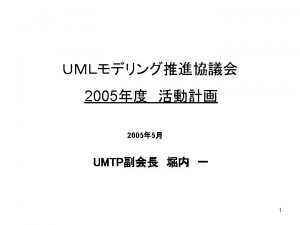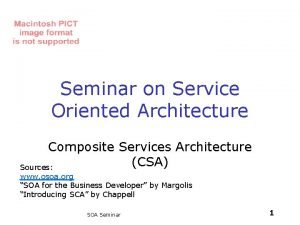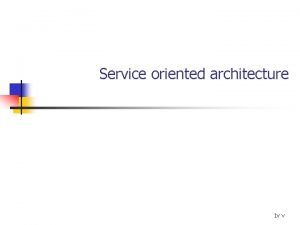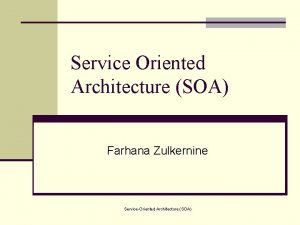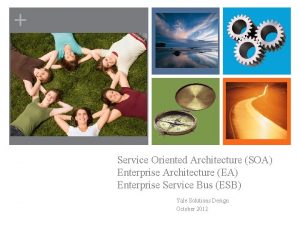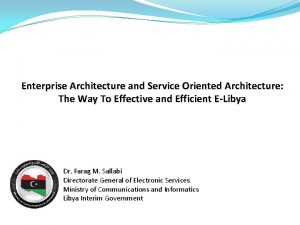Application of Service Oriented Architecture in Statistics New




















- Slides: 20

Application of Service Oriented Architecture in Statistics New Zealand UNSC Modernisation of the Statistical Process Seminar New York, February 24, 2010 Geoff Bascand & Matjaz Jug

Drivers for IT Architecture • Agility: transformational changes like shift towards the increased use of administrative data, more automated data processing etc. • Cost & Reuse: standardisation and reducing high costs of development and maintenance of statistical production systems. • Integration: need for integration of outsourced statistical tools and legacy application assets • Configuration: response to frequent changes in data sources, questionnaires, methodology and classifications.

SOA Definition • The Open Group describes Service Oriented Architecture (SOA) as a: – “style of IT architecture that delivers agility and Boundaryless Information Flow™. It is deployed on an increasing scale in enterprises today. ” • SOA is a message-based, independent component architecture where: – communication between components is managed by a “service (or process) manager” that mediates communication, coordination and cooperation among components through messages. The message carries data and process data.

SOA Benefits • Increased agility: organisations should be able to more quickly respond to changes in business process and external environment. • Reduction of cost through reuse: new IT systems should be able to leverage the most readily available code and services from across the organization and externally. • Better possibilities for integration using loosely coupled framework and orchestration. • Configuration rather than programming

Situation in Statistical Organizations • Many lessons learnt from early adopters • Even now there are not a lot of statistical organisations implementing SOA on a large scale • We are “behind” compared with some other sectors like the Airline Industry • WHY? Are we really so different?

In Some Areas We are Different! • Many semantically diverse data structures • Frequent change in data structure, sources, questionnaires • Specific requirements like data confidentiality • Many stove-piped legacy application assets • Mainly non-transactional processing • End-user processing environments

Learning from Data Warehousing and Metadata-Driven Projects 1. High degree of organisational change is required which is usually slow process. 2. It is difficult to establish new governance. 3. New architecture usually requires complete replacement of legacy application assets portfolio. 4. Software development capability is difficult to upgrade and maintain in-house 5. Common challenge organisations often face involves effectively managing metadata. 6. Lack of standardisation – it appears every new paradigm requires more of it.

Additional lessons from early SOA attempts • Standardisation of services and data structures is vital • Too broad a business or services scope, then costs of generality & development are high • Too specific a service or business request, then benefits of re-usability are limited • Performance degrades with volume

Architecture in Stats NZ now – Platform approach and Shared Services (SOA) STATISTICAL INFRASTRUCTURE MICRO ECONOMIC C O L L E C T MACROECONOMIC SOCIAL CENSUS IT INFRASTRUCTURE D I S S E M I N A T I O N

Statistical Infrastructure Frames and Registers Classification Management Metadata Management Processing - Micro Economic Statistics Collection Administrative Data Platform for Micro economic statistics (BESt) Methodologies Dissemination Content Management (www. stats. govt. nz) Other systems (mostly legacy) Imaging Future (Web) Builder Processing - Macro Economic Statistics Platform for National Accounts (DNA) Other systems (mostly legacy) Processing - Social/Household Statistics Platform for HH statistics (POSS) Other systems (mostly legacy) Data Dissemination Management CATI Table Respondents & Collection Management CAPI Infoshare Business Toolbox Future Census Platform IT Infrastructure Hardware Server Software (OS, email, SQL DB, OLAP, CRM, CMS) Applications & Tools Desktop Software (MS Office, Lotus Notes)

SOA in Data Collection • Description: data collected through CATI, CAPI and Imaging are loaded (pushed) using messaging infrastructure to production databases. The grain is individual questionnaire response. Load service was built to deliver data to Legolution and POSS Input Data Environment (now Social Input Store). • Challenges: We have dropped this approach in Process phase due to difficulties in moving large amounts of data as a messages. Requirement to pass process-metadata was overlooked so additional metadata transfer had to be used • Benefits: infrastructure required for transactional data collection where every response can be pushed to production systems. This approach is anticipated as a result of Standard Business Reporting project.

SOA in Data Processing • Description: Data is now transferred using ETL packages (pull). Service is used to initiate ETL packages. Configuration store is a central place where process is configured (metadata) and is currently used by two systems: BESt platform and SOFIE processing system. • Challenges: Reuse of ETL packages is limited to the single platform (BESt) but some components (configuration store) can be used by other systems as well (as part of statistical infrastructure). • Benefits: Highly configurable process workflow enabling WHAT-IF scenarios.


SOA in Data Dissemination • Description: Dissemination tool Business Toolbox is using SDMX query service to get aggregated data from dissemination data warehouse OECD. stat and present it in a customized user friendly way. • Challenges: integration of data warehouse with output production (legacy) systems. • Benefits: Presentation of information is not dependent on the physical structure in data warehouse, possibility to easily add new SDMXbased web components as well as new data.


SOA in Statistical Infrastructure • Description: Coding is the first example of statistical infrastructure to be offered through the service interface (internally and externally). CCS coder will offer automated coding service based on classification metadata in CARS. • Challenges: metadata management & standardisation. • Benefits: Statistical infrastructure (metadata management systems, registers) can provide services to internal and external platforms and individual systems.

How to Start? Areas Where SOA Can Deliver Significant Value • Metadata services: a good candidate for reuse in many stovepipe and corporate applications. • Statistical tools/components: making them more interoperable using service interface would significantly improve the possibilities to integrate them in different IT environments and therefore increase their shared usage and collaboration.

Summary • Iterative development (low hanging fruit first) and proofs of the concepts • No emphasis on any particular approach: SOA, DW and metadata-driven architecture are used together in a way which maximizes benefits and minimizes risk • Strong focus on use of standards (SDMX) • Common IT Infrastructure is enabling additional consolidation (MS SQL Server & Analysis Services, SAS Server, Blaise, . NET)

Annex: Systems Architecture and SOA Use – Detailed Version • The following slide is a detailed picture of our systems architecture – – Box 1 highlights SOA in the collections area Box 2 highlights SOA in the processing area Box 3 highlights SOA in the dissemination area Box 4 highlights SOA in statistical infrastructure

Architecture and SOA Use – Detailed Version
 Service oriented web application
Service oriented web application Service oriented architecture notes
Service oriented architecture notes Characteristics of service oriented architecture
Characteristics of service oriented architecture Service oriented architecture franchise
Service oriented architecture franchise Service oriented architecture diagram
Service oriented architecture diagram Soa
Soa Service oriented architecture soap
Service oriented architecture soap Microsoft service oriented architecture
Microsoft service oriented architecture Application of statistics in architecture
Application of statistics in architecture Consumer oriented vs trade-oriented sales promotion
Consumer oriented vs trade-oriented sales promotion What is a column row db
What is a column row db Prepare a service blueprint for 100 yen sushi
Prepare a service blueprint for 100 yen sushi Portal oriented application integration
Portal oriented application integration Consumer oriented e commerce application
Consumer oriented e commerce application Information oriented application integration
Information oriented application integration Information-oriented examples
Information-oriented examples Application oriented networking
Application oriented networking Introduction to statistics what is statistics
Introduction to statistics what is statistics Resource oriented architecture
Resource oriented architecture Transient asynchronous communication
Transient asynchronous communication Service oriented infrastructure
Service oriented infrastructure
